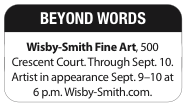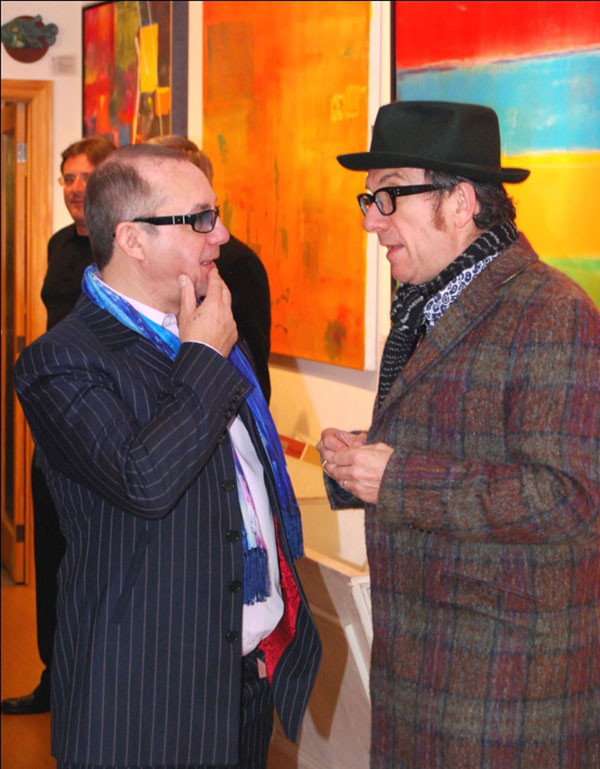The abstract art of Elton John lyricist Bernie Taupin correlates with his music more than he lets on
RICH LOPEZ | Staff Writer
lopez@dallasvoice.com
To be a star in the rock universe without really ever being a rock star is a feat unto itself. It is a position Bernie Taupin knows well. Famous more for his collabs with Sir Elton John as well as other high-profile musicians, Taupin is easily one of music’s most legendary lyricists: “Candle in the Wind,” “Rocket Man,” “Levon” are giants in the rock ‘n’ roll vernacular.
But Taupin’s creativity doesn’t end with hit after lyrical hit. With Dallas on his itinerary, Taupin comes here as a different kind of artist.
“What I’ve got going keeps me pretty busy,” he says in his slightly gruff British accent. “I’m just cracking 60 and I’m pretty satisfied with things.”
To his stellar track record in contemporary music, Taupin adds the title painter. His abstracts have received critical acclaim on par with his songs, and Dallas’ Wisby Smith Fine Art gallery will feature Beyond Words, a collection of Taupin’s visual art.
At times, Taupin sounds fickle about his own work. Although he likens the creative processes of songwriting to painting, he prefers now to discuss just his art … even though one might not exist without the other.
 “Painting is just a natural extension in creation from writing songs,” he says. “My songs don’t influence my paintings, but it is another step.”
“Painting is just a natural extension in creation from writing songs,” he says. “My songs don’t influence my paintings, but it is another step.”
Like his abstracts, Taupin does say that his work process has its origins in the songs he wrote — mostly those in which he and Elton John might have been trying to say something in lyrics without saying something. John is much more out now than he was 40 years ago. In his rock heyday, John almost married a woman and then came out as bi. There has always been speculation that many of John’s songs had hidden or double meanings. Taupin rather likes that — even now.
“I like people to use their imagination,” he says. “Things like that just happen. You can’t over-think things. It’s just what comes out. There are a lot of similarities between songwriting and painting and a lot of the same things are going on. They’re both quite lyrical. It’s par for the course that we might cloak some lyrics but it’s just more interesting and people can come up with their own interpretation.”
Taupin says he has always doodled or drawn, but it wasn’t until the early ‘90s that the spark to truly create on canvas flared. At a ranch in Southern California, he found his Walden Pond. With all the travel that comes with being a music icon, he could finally settle in and let his inspiration flourish.
“The locale here is very inspiring and pretty spectacular, which all just lends itself to any sense of imagination,” he boasts. “How can you not be inspired by these surroundings? The facilities here give me much more opportunity to create. The space is great and it all really came together at the right time.”
Despite a seemingly endless supply of creative energy, even Taupin admits to having dry spells. As he explains, it’s a common thing for any artist, although it’s not the same for his music and his art. When it comes to writing a song, he’s far more driven by the business of it.
“As far as writing, I work when I need to work. When I’m preparing an album, which may be every couple of years,” he says. “I’m not writing all the time. My painting is far more consistent and I’ve been working a lot recently because I’ve been motivated by the series of shows coming up. But I’m also not painting all the time either.”
When he shows in Dallas, Taupin expects viewers to take away their own thoughts on his work. There is no wrong answer to the questions his art raises. But is it fair — when he asks audiences to eschew labels or titles — that he names his work?
“I’d much rather have a title. Untitleds are rather dull,” he says. “My titles at least give a viewer a starting point to come up with their own conclusion. The one thing I don’t like doing is explaining a song or my work. Like some of my songs, paintings need to be thought about. It’s not up to me put ideas in their heads, but to interest the viewer and ask them to use their mind.”
This article appeared in the Dallas Voice print edition September 9, 2011.














